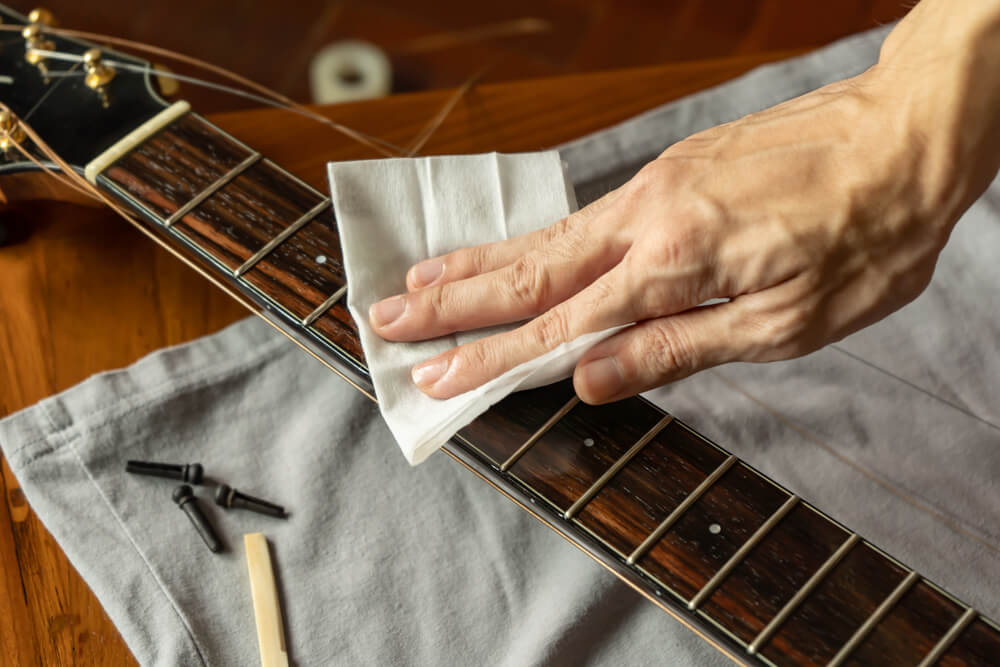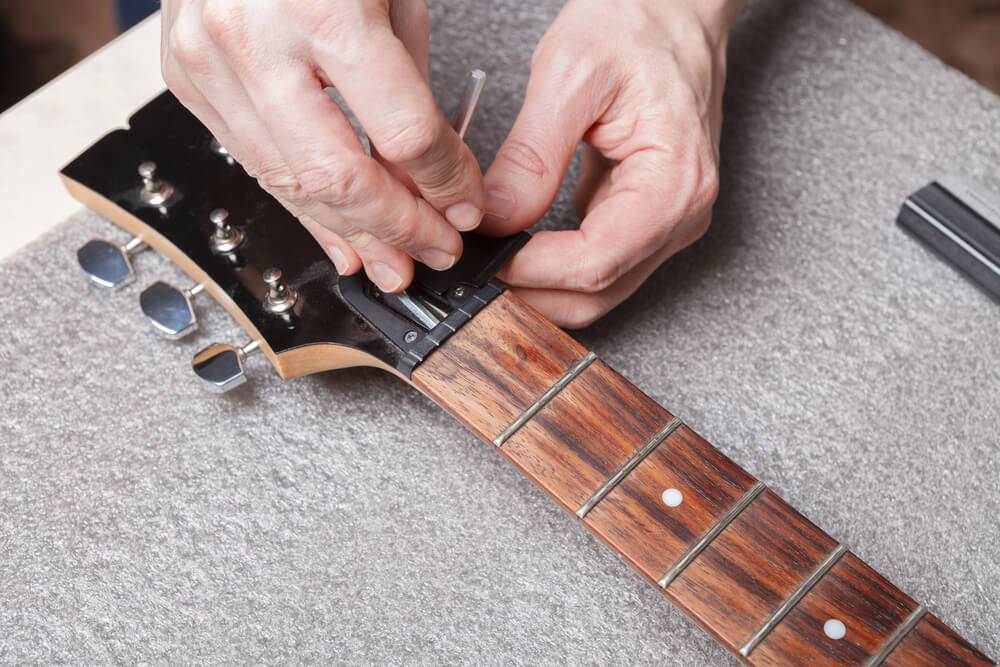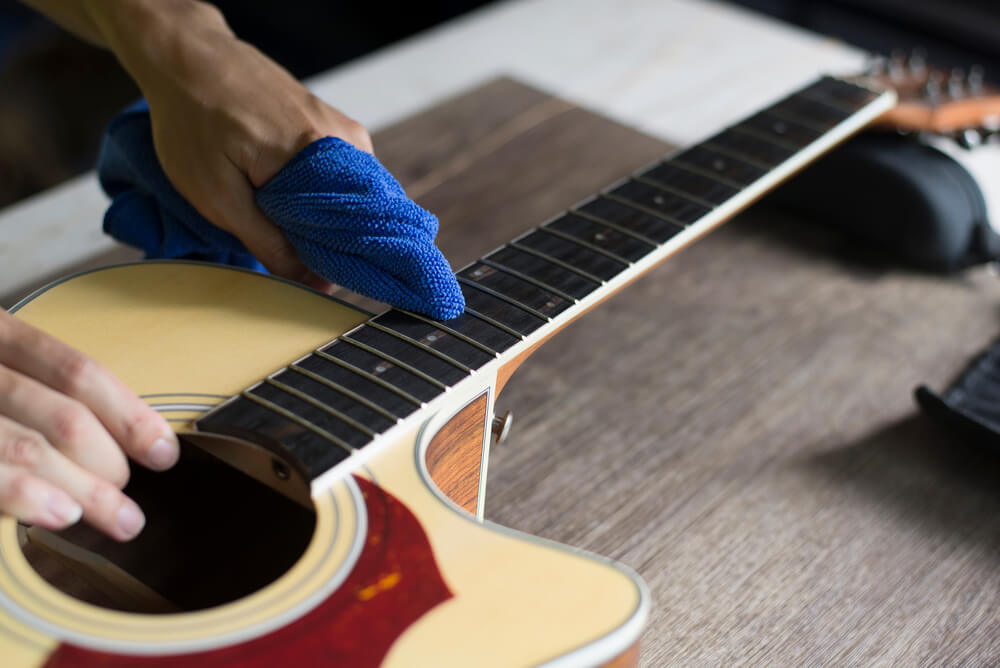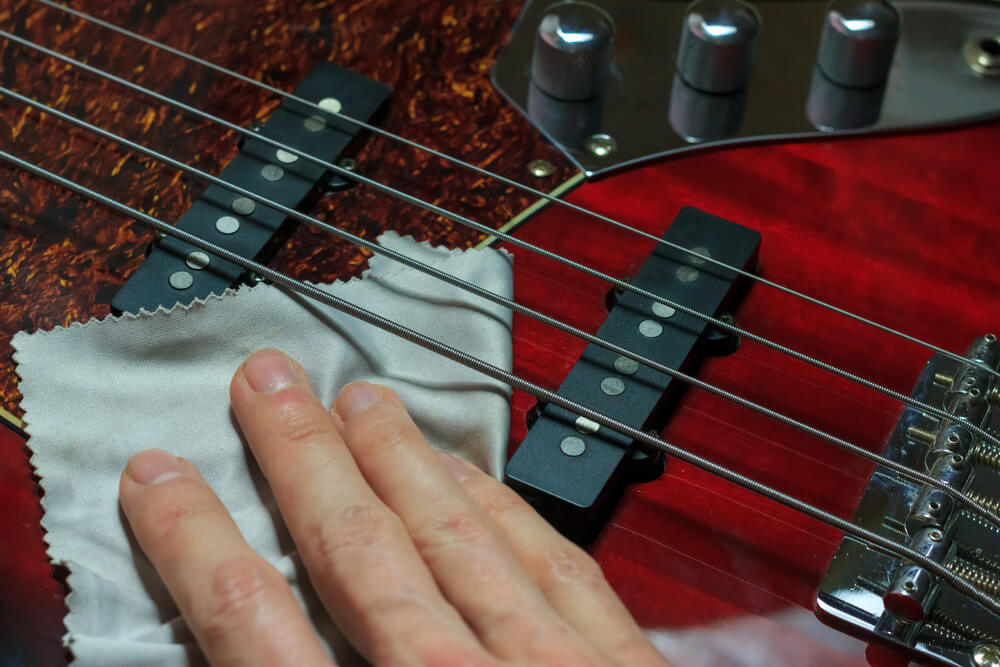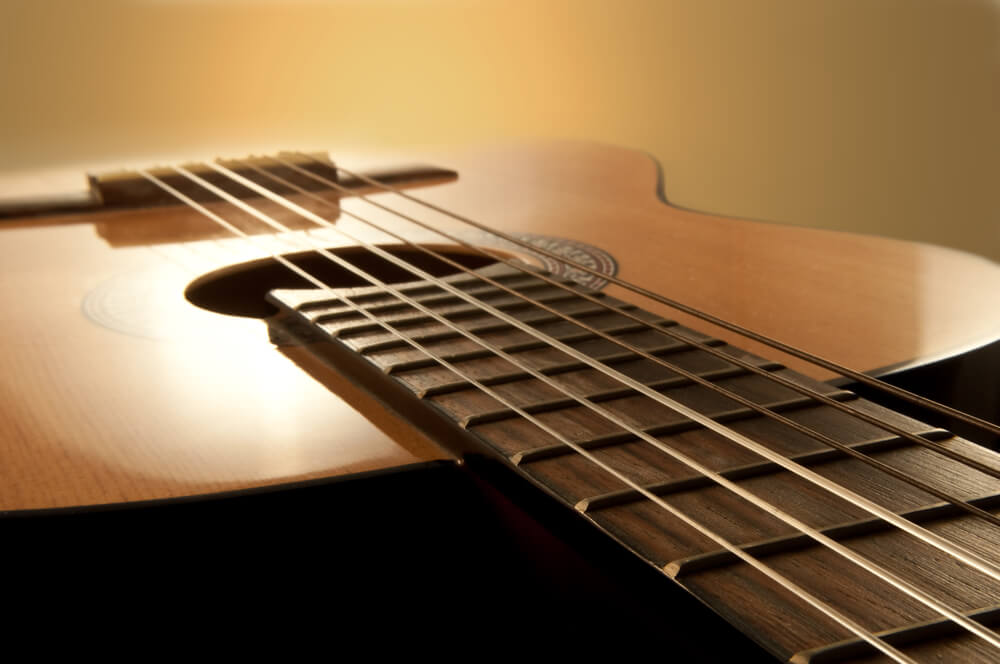Knowing how to clean a guitar fretboard is essential for maintaining the playability and longevity of your instrument. Over time, dirt, sweat, and grime can accumulate on the fretboard, potentially affecting the sound quality and feel of your guitar.
Regular fretboard cleaning can help prevent this buildup, ensuring that your guitar remains in top condition for performances and practice sessions alike.
Understanding the importance of cleaning and knowing the signs of a dirty fretboard is vital for any guitarist, regardless of skill level. With the right cleaning supplies and techniques, you can keep your fretboard looking and sounding its best.
From pre-cleaning preparations to post-cleaning actions, mastering the art of fretboard maintenance will enhance your guitar-playing experience.
Key Takeaways
- Regular fretboard cleaning is crucial for maintaining the playability and longevity of your guitar.
- Knowing the signs of a dirty fretboard and using suitable cleaning supplies are important steps in the cleaning process.
- Pre-cleaning preparations, a step-by-step cleaning process, and proper post-cleaning actions will keep your fretboard in optimal condition.
How To Clean A Guitar Fretboard
Cleaning your guitar fretboard is essential for multiple reasons.
First and foremost, it helps maintain the instrument’s playability. Dirt, oils, and sweat from your fingers can accumulate on the fretboard over time, making it harder for you to play smoothly and precisely. Regular cleaning can prevent this buildup and ensure your guitar stays in top condition.
Moreover, the guitar fretboard is often made of wood, which can dry out and shrink if not properly maintained. A dry fretboard might lead to issues with the frets, such as them becoming loose or protruding out of the wood.
Fortunately, cleaning and conditioning the fretboard can significantly reduce the risk of such problems.
Maintaining your fretboard also contributes to preserving your guitar’s tone quality. Grime and dirt trapped on the fretboard and the frets can dampen the vibration of the strings, resulting in a duller, less vibrant sound.
By keeping the fretboard clean, you can ensure that the guitar produces its best possible tone.
Lastly, regular cleaning prolongs the life of your guitar strings. Dirty fretboards can accelerate the corrosion of the strings, forcing you to replace them more frequently.
Cleaning the fretboard can help you save on string replacement costs over time.
In summary, cleaning your guitar fretboard is crucial for maintaining its playability, tone quality, and overall longevity. It’s a simple yet effective way to keep your guitar in good condition and enhance your playing experience.
Identifying Signs Of A Dirty Fretboard
As a guitar player, it’s important to keep your fretboard clean to maintain optimal playability and prolong the life of your instrument.
In this section, we’ll discuss some common signs that indicate a dirty fretboard, so you can take the necessary steps to clean and maintain it.
One key sign of a dirty fretboard is the appearance of grime and buildup on the frets and fingerboard. The more you play, the more your fingers’ natural oils, sweat, and dead skin cells accumulate on the fretboard.
This buildup can be more apparent on lighter-colored woods, such as maple, and might look like a dark, sticky residue.
Another sign of a dirty fretboard is the presence of dirt or dust in the spaces between the frets. This is especially noticeable if you store your guitar in a dusty environment.
Over time, the accumulation of dust can negatively affect the sound and playability of your instrument.
Additionally, pay attention to the smell of your fretboard. Guitars with a heavy accumulation of dirt, grime, and sweat can sometimes emit an unpleasant odor.
If you notice a musty or stale smell coming from your fretboard, it’s likely overdue for a cleaning.
Lastly, consider the playability of your guitar. If you’re finding it harder to play or slide your fingers along the strings, it could be due to the buildup of dirt and grime on the fretboard.
Cleaning it can help improve playability and enhance your overall guitar-playing experience. By keeping an eye out for these signs, you can ensure that your fretboard remains clean and in good condition.
Remember that regular cleaning and maintenance are crucial aspects of keeping your guitar in top shape, so make a habit of inspecting and caring for your fretboard as needed.
Gathering Essential Cleaning Supplies
Before you start cleaning your guitar’s fretboard, it’s important to gather the right supplies to ensure a safe and effective outcome.
In this section, we’ll discuss choosing fretboard cleaning products and selecting fretboard-friendly tools.
Choosing Fretboard Cleaning Products
It’s crucial to choose the appropriate cleaning products based on your guitar fretboard’s material. For unsealed or unfinished necks, such as rosewood and ebony fretboards, using an oil-based cleaner like lemon oil or another mineral oil is advisable.
Avoid using harsh chemicals or aerosolized wood polishes like Pledge, as they can damage your guitar’s finish.
Selecting Fretboard Friendly Tools
When it comes to cleaning tools, it’s best to pick gentle and non-abrasive items that won’t scratch or damage your guitar.
Some recommended tools include:
- Cotton swabs or Q-tips: Ideal for removing dirt found on the side of the frets and for reaching tight spaces.
- Cotton balls or face-cleaning pads: Useful for cleaning the middle part between frets.
- Soft, lint-free microfiber cloth: Perfect for wiping down the fretboard after cleaning and conditioning.
Remember to always approach fretboard cleaning with care and patience. Following these guidelines will ensure your guitar fretboard stays clean and in optimal playing condition.
Pre-Cleaning Preparations
Before getting into the actual cleaning process, there are a few important steps to take to ensure a smooth and efficient process. In this section, we’ll discuss how to properly remove the strings from your guitar and protect the body while cleaning the fretboard.
Removing The Strings
Firstly, you’ll need to remove the strings from your guitar. Loosen each string gradually, starting with the thickest (low E) and working your way down to the thinnest (high E).
As you loosen each string, ensure not to apply too much pressure to avoid causing damage to the tuning pegs. Once the strings are slackened, carefully remove them from the bridge and tuning pegs.
Make sure to set the strings aside in a safe place if you plan to reuse them or dispose of them properly if they are old and being replaced.
Here’s a helpful guide on how to clean a guitar fretboard.
Protecting The Guitar Body
To protect the guitar body while cleaning the fretboard, lay a clean, soft cloth or towel on the working surface to avoid scratches or damage. Place your guitar on the cloth with the fretboard facing upward.
If you have a neck support, use it to keep the guitar stable during the cleaning process. If not, you can improvise by using a folded towel or cloth underneath the neck of the guitar.
Additionally, you can cover the pickups and other sensitive parts of the guitar with painter’s tape or masking tape. This will prevent cleaning solutions or debris from getting into these areas and potentially causing damage.
Nonetheless, be careful not to cover up any inlays or other intricate details on the guitar, as you’ll want to clean those as well. With the proper preparations in place, you’re now ready to begin cleaning the fretboard of your guitar.
Keep these tips in mind, and you’ll be on your way to maintaining a clean and well-performing instrument.
Step By Step Cleaning Process
In this section, we will discuss the step-by-step process of cleaning a guitar fretboard.
Applying The Cleaning Solution
First, identify your fretboard type, as cleaning methods may vary for each material. Then, remove the guitar strings to access the fretboard. Protect your guitar by placing a soft cloth or towel underneath it.
Apply a gentle cleaning solution specifically designed for your fretboard, such as vegetable oil soap or lemon oil, on a clean cloth or directly onto the fretboard.
Be sure not to use excessive amounts of liquid, as this may cause damage to your guitar.
Scrubbing The Fretboard
Once the cleaning solution is applied, use a soft cloth, toothbrush, Q-tip, or cotton swab to gently scrub the fretboard, focusing on the areas with visible dirt and grime. Ensure that you follow the wood grain while scrubbing to prevent scratches.
Pay special attention to the fret edges and in between the frets, as these areas tend to accumulate the most dirt.
Wiping Down And Drying
After scrubbing the fretboard, wipe it down with a clean and dry cloth, removing any remaining cleaning solution or residue.
Make sure to reach all areas, including the fret edges and in between the frets. Once the entire fretboard is clean, allow it to air dry for a short period before restringing your guitar.
Regularly cleaning your fretboard helps maintain optimal performance and keeps your guitar in good condition.
Post-Cleaning Actions
After you’ve cleaned your guitar fretboard, there are a few important steps to take for optimal results.
Re-stringing The Guitar
Now that your fretboard is clean, it’s time to restring your guitar. Make sure you use the correct string gauge for your guitar to maintain proper tension and playability.
When restringing, try to wind the strings uniformly around the tuning pegs to avoid any potential tuning issues. Remember to stretch your new strings to help them settle into place faster and maintain their tune.
Checking Sound Quality
Once your guitar is re-strung, it’s crucial to check the sound quality. Play each note individually and ensure that the intonation is as desired.
If you notice any buzzing or odd-sounding notes, you may need to adjust the truss rod and bridge height or make other necessary adjustments.
It’s also a good time to check the overall tone and resonance of your guitar, as cleaning and restringing can improve its sound quality.
Make sure to maintain your guitar’s fretboard regularly to keep it in excellent condition and prolong its lifespan.
Regular cleaning and maintenance will enhance your playing experience and give you the best possible sound from your instrument.
Maintenance Tips For A Clean Fretboard
Maintaining a clean fretboard is essential for keeping your guitar in top condition and sounding its best.
Here are some useful tips for taking care of your instrument’s fretboard:
- Identify your fretboard type: Before starting the cleaning process, it’s important to know the material of your guitar’s fretboard. Common materials include rosewood, ebony, and maple. Each material may require slightly different care methods.
- Removing the strings: To clean your fretboard thoroughly, you’ll need to remove the guitar strings. This not only makes it easier to access the fretboard but also gives you the opportunity to check the strings for wear and replace them if necessary.
- Gentle cleaning: Start by using a soft cloth to gently wipe away dust and grime from the fretboard. For stubborn dirt and build-up, you can use a toothbrush to gently scrub between the frets, being careful not to damage the wood.
- Condition the fretboard: After cleaning, it’s essential to condition the wood of your fretboard, especially if it is made of rosewood or ebony. Lemon oil or almond oil can help nourish the wood, preserving its natural look and feel.
- Use appropriate cleaning products: Avoid using harsh chemicals or abrasive materials on your fretboard. Instead, opt for guitar-specific cleaning products, such as those mentioned above, to prevent damage to the wood or finish.
- Polish the hardware: While you have the strings off your guitar, take the opportunity to polish the frets and hardware. This can improve the appearance of your instrument and prevent corrosion.
- Regular maintenance: To keep your fretboard in optimal condition, establish a regular maintenance routine, cleaning and conditioning it as needed. This will help ensure the longevity and performance of your guitar.
By following these maintenance tips, you can enjoy a clean fretboard and great-sounding guitar for years to come.
Frequently Asked Questions
What is the best method for cleaning a rosewood fretboard?
To clean a rosewood fretboard, first remove the strings. Then, use a soft, lint-free cloth and a specially-formulated guitar fretboard cleaner or a small amount of vegetable oil-based soap, like Murphy’s, to clean the fretboard.
Make sure to remove all soap residue to prevent buildup. Once clean, use a fretboard conditioner to nourish the wood and protect it from moisture.
Can household items be safely used for fretboard cleaning?
Some household items can be safely used for cleaning a guitar fretboard. For example, you can use a clean, soft cloth to gently remove dust and grime.
In the case of stubborn dirt, a small amount of white vinegar or isopropyl alcohol mixed with some water can be effective. When using these items, remember to test on a small inconspicuous area first and always follow up with guitar-specific oils or conditioners.
Which fretboard cleaners are recommended?
Several commercial products are designed specifically for guitar fretboard cleaning and conditioning.
Some reputable brands include Dunlop, Fender, and MusicNomad. Before using any product, ensure it is suitable for your particular type of fretboard material, such as rosewood, maple, or ebony.
Is it possible to clean a fretboard with strings still on?
It is possible to clean your guitar fretboard with strings still on, but it might not be as thorough. You can loosen the strings to access the frets and fretboard surfaces.
Use a soft cloth and a guitar-specific cleaner to wipe away dirt and grime, being careful not to touch the strings with the cleaning solution.
What precautions should be taken while using alcohol-based products on a guitar fretboard?
When using alcohol-based products on a guitar fretboard, be cautious and take the following precautions:
- Always dilute the alcohol with water to reduce the risk of damaging the wood or finish.
- Test on a small, inconspicuous area before applying it to the entire fretboard.
- Apply the solution sparingly with a soft cloth, avoiding contact with the guitar body or other hardware.
How can I remove gunk from my guitar frets without using steel wool?
To remove gunk from your guitar frets without using steel wool, try using a soft toothbrush, a nylon pad, or a specialized fret cleaning tool like a rubber eraser.
Gently work on the area with the tool of your choice until the gunk loosens and can be wiped away.
Remember to protect the guitar body with a soft cloth while cleaning, and always follow up with a conditioner appropriate for your type of fretboard.


